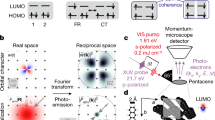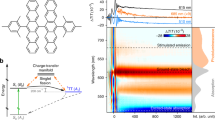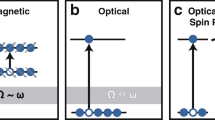Abstract
Singlet fission is the spin-allowed conversion of a spin-singlet exciton into a pair of spin-triplet excitons residing on neighbouring molecules. To rationalize this phenomenon, a multiexcitonic spin-zero triplet-pair state has been hypothesized as an intermediate in singlet fission. However, the nature of the intermediate states and the underlying mechanism of ultrafast fission have not been elucidated experimentally. Here, we study a series of pentacene derivatives using ultrafast two-dimensional electronic spectroscopy and unravel the origin of the states involved in fission. Our data reveal the crucial role of vibrational degrees of freedom coupled to electronic excitations that facilitate the mixing of multiexcitonic states with singlet excitons. The resulting manifold of vibronic states drives sub-100 fs fission with unity efficiency. Our results provide a framework for understanding singlet fission and show how the formation of vibronic manifolds with a high density of states facilitates fast and efficient electronic processes in molecular systems.
This is a preview of subscription content, access via your institution
Access options
Subscribe to this journal
Receive 12 print issues and online access
$259.00 per year
only $21.58 per issue
Buy this article
- Purchase on Springer Link
- Instant access to full article PDF
Prices may be subject to local taxes which are calculated during checkout






Similar content being viewed by others
References
Smith, M. B. & Michl, J. Singlet fission. Chem. Rev. 110, 6891–6936 (2010).
Wilson, M. W. B. et al. Ultrafast dynamics of exciton fission in polycrystalline pentacene. J. Am. Chem. Soc. 133, 11830–11833 (2011).
Hanna, M. C. & Nozik, A. J. Solar conversion efficiency of photovoltaic and photoelectrolysis cells with carrier multiplication absorbers. J. Appl. Phys. 100, 074510 (2006).
Ehrler, B., Wilson, M. W., Rao, A., Friend, R. H. & Greenham, N. Singlet exciton fission-sensitized infrared quantum dot solar cells. Nano Lett. 12, 1053–1057 (2012).
Congreve, D. N. et al. External quantum efficiency above 100% in a singlet-exciton-fission-based organic photovoltaic cell. Science 340, 334–337 (2013).
Burdett, J. J. & Bardeen, C. J. The dynamics of singlet fission in crystalline tetracene and covalent analogs. Acc. Chem. Res. 46, 1312–1320 (2013).
Dillon, R. J., Piland, G. B. & Bardeen, C. J. Different rates of singlet fission in monoclinic versus orthorhombic crystal forms of diphenylhexatriene. J. Am. Chem. Soc. 135, 17278–17281 (2013).
Mastron, J. N., Roberts, S. T., McAnally, R. E., Thompson, M. E. & Bradforth, S. E. Aqueous colloidal acene nanoparticles: a new platform for studying singlet fission. J. Phys. Chem. B 117, 15519–15526 (2013).
Lee, J. et al. Singlet exciton fission in a hexacene derivative. Adv. Mater. 25, 1445–1448 (2013).
Musser, A. J. et al. Activated singlet exciton fission in a semiconducting polymer. J. Am. Chem. Soc. 135, 12747–12754 (2013).
Yost, S. R. et al. A transferable model for singlet-fission kinetics. Nature Chem. 6, 492–497 (2014).
Herz, J. et al. Acceleration of singlet fission in an aza-derivative of TIPS-pentacene. J. Phys. Chem. Lett. 5, 2425–2430 (2014).
Busby, E. et al. Multiphonon relaxation slows singlet fission in crystalline hexacene. J. Am. Chem. Soc. 136, 10654–10660 (2014).
Beljonne, D., Yamagata, H., Brédas, J. L., Spano, F. C. & Olivier, Y. Charge-transfer excitations steer the Davydov splitting and mediate singlet exciton fission in pentacene. Phys. Rev. Lett. 110, 226402 (2013).
Johnson, J. C., Nozik, A. J. & Michl, J. The role of chromophore coupling in singlet fission. Acc. Chem. Res. 46, 1290–1299 (2013).
Zimmerman, P. M., Musgrave, C. B. & Head-Gordon, M. A correlated electron view of singlet fission. Acc. Chem. Res. 46, 1339–1347 (2013).
Wang, L., Olivier, Y., Prezhdo, O. V. & Beljonne, D. Maximizing singlet fission by intermolecular packing. J. Phys. Chem. Lett. 5, 3345–3353 (2014).
Berkelbach, T. C., Hybertsen, M. S. & Reichman, D. R. Microscopic theory of singlet exciton fission. III. Crystalline pentacene. J. Chem. Phys. 141, 074705 (2014).
Zimmerman, P. M., Zhang, Z. & Musgrave, C. B. Singlet fission in pentacene through multi-exciton quantum states. Nature Chem. 2, 648–652 (2010).
Zeng, T., Ananth, N. & Hoffmann, R. Seeking small molecules for singlet fission: a heteroatom substitution strategy. J. Am. Chem. Soc. 136, 12638–12647 (2014).
Coto, P. B., Sharifzadeh, S., Neaton, J. B. & Thoss, M. Low-lying electronic excited states of pentacene oligomers: a comparative electronic structure study in the context of singlet fission. J. Chem. Theor. Comput. 11, 147–156 (2014).
Parker, S. M., Seideman, T., Ratner, M. A. & Shiozaki, T. Model Hamiltonian analysis of singlet fission from first principles. J. Phys. Chem. C 118, 12700–12705 (2014).
Merrifield, R. E., Avakian, P. & Groff, R. P. Fission of singlet excitons into pairs of triplet excitons in tetracene crystals. Chem. Phys. Lett. 3, 386–388 (1969).
Smith, M. B. & Michl, J. Recent advances in singlet fission. Annu. Rev. Phys. Chem. 64, 361–386 (2013).
Chan, W.-L. et al. Observing the multiexciton state in singlet fission and ensuing ultrafast multielectron transfer. Science 334, 1541–1545 (2011).
Chan, W.-L., Ligges, M. & Zhu, X. Y. The energy barrier in singlet fission can be overcome through coherent coupling and entropic gain. Nature Chem. 4, 840–845 (2012).
Alguire, E. C., Subotnik, J. E. & Damrauer, N. H. Exploring non-condon effects in a covalent tetracene dimer: how important are vibrations in determining the electronic coupling for singlet fission? J. Phys. Chem. A 119, 299–311 (2015).
Renaud, N. & Grozema, F. C. Intermolecular vibrational modes speed up singlet fission in perylenediimide crystals. J. Phys. Chem. Lett. 6, 360–365 (2014).
Musser, A. J. et al. Evidence for conical intersection dynamics mediating ultrafast singlet exciton fission. Nature Phys. 11, 352–357 (2015).
Jonas, D. M. Two-dimensional femtosecond spectroscopy. Annu. Rev. Phys. Chem. 54, 425–463 (2003).
Egorova, D. Detection of electronic and vibrational coherences in molecular systems by 2D electronic photon echo spectroscopy. Chem. Phys. 347, 166–176 (2008).
Butkus, V., Zigmantas, D., Valkunas, L. & Abramavicius, D. Vibrational vs. electronic coherences in 2D spectrum of molecular systems. Chem. Phys. Lett. 545, 40–43 (2012).
Egorova, D. Self-analysis of coherent oscillations in time-resolved optical signals. J. Phys. Chem. A 118, 10259–10267 (2014).
Brixner, T., Stenger, J., Vaswani, H. M., Blankenship, R. E. & Fleming, G. R. Two-dimensional spectroscopy of electronic couplings in photosynthesis. Nature 343, 625–628 (2005).
Ostroumov, E. E., Mulvaney, R. M., Cogdell, R. J. & Scholes, G. D. Broadband 2D electronic spectroscopy reveals a carotenoid dark state in purple bacteria. Science 340, 52–56 (2013).
Halpin, A. et al. Two-dimensional spectroscopy of a molecular dimer unveils the effects of vibronic coupling on exciton coherences. Nature Chem. 6, 196–201 (2014).
Tiwari, V., Peters, W. K. & Jonas, D. M. Electronic resonance with anticorrelated pigment vibrations drives photosynthetic energy transfer outside the adiabatic framework. Proc. Natl Acad. Sci. USA 110, 1203–1208 (2013).
Lazonder, K., Pshenichnikov, M. S. & Wiersma, D. A. Easy interpretation of optical two-dimensional correlation spectra. Opt. Lett. 31, 3354–3356 (2006).
Panitchayangkoon, G. et al. Long-lived quantum coherence in photosynthetic complexes at physiological temperature. Proc. Natl Acad. Sci. USA 107, 12766–12770 (2010).
Bayliss, S. L. et al. Geminate and nongeminate recombination of triplet excitons formed by singlet fission. Phys. Rev. Lett. 112, 238701 (2014).
Wilson, M. W. B., Rao, A., Ehrler, B. & Friend, R. H. Singlet exciton fission in polycrystalline pentacene: from photophysics toward devices. Acc. Chem. Res. 46, 1330–1338 (2013).
Rao, A. et al. Exciton fission and charge generation via triplet excitons in pentacene/C60 bilayers. J. Am. Chem. Soc. 132, 12698–12703 (2010).
Egorova, D. Oscillations in two-dimensional photon-echo signals of excitonic and vibronic systems: stick-spectrum analysis and its computational verification. J. Chem. Phys. 140, 034314 (2014).
De Boeij, W. P., Pshenichnikov, M. S. & Wiersma, D. A. System–bath correlation function probed by conventional and time-gated stimulated photon echo. J. Phys. Chem. 100, 11806–11823 (1996).
Song, Y., Hellmann, C., Stingelin, N. & Scholes, G. D. The separation of vibrational coherence from ground- and excited-electronic states in P3HT film. J. Chem. Phys. 142, 212410 (2015).
Schlau-Cohen, G. S. et al. Elucidation of the timescales and origins of quantum electronic coherence in LHCII. Nature Chem. 4, 389–395 (2012).
Egorova, D. & Domcke, W. Coherent vibrational dynamics during ultrafast photoinduced electron-transfer reactions: quantum dynamical simulations within multilevel Redfield theory. Chem. Phys. Lett. 384, 157–164 (2004).
Chan, W.-L., Tritsch, J. R. & Zhu, X. Y. Harvesting singlet fission for solar energy conversion: one- versus two-electron transfer from the quantum mechanical superposition. J. Am. Chem. Soc. 134, 18295–18302 (2012).
Falke, S. M. et al. Coherent ultrafast charge transfer in an organic photovoltaic blend. Science 344, 1001–1005 (2014).
Romero, E. et al. Quantum coherence in photosynthesis for efficient solar-energy conversion. Nature Phys. 10, 676–682 (2014).
Acknowledgements
The authors thank T. Jansen and M. Pschenichnikov for discussions, D. Palecek for help with ~580 nm 2D experiments and M. Tabachnyk for help with preparing samples. This work was supported by Laserlab–Europe (project no. LLC001945). A.A.B. is currently a Royal Society University Research Fellow. He also acknowledges a Veni grant from the Netherlands Organization for Scientific Research (NWO). A.R., S.E.M. and A.W.C. acknowledge the Winton Programme for the Physics of Sustainability for support.
Author information
Authors and Affiliations
Contributions
A.A.B. and A.R. conceived the study. M.W.B.W. and A.R. produced and characterized the samples. A.A.B., D.Z. and A.R. planned and performed the 2D experiments. T.K. performed c.w. Raman experiments. A.A.B., S.E.M., A.W.C., D.E. and A.R. analysed the data. S.E.M., A.W.C. and D.E. developed the model and performed theoretical calculations. A.A.B., S.E.M., A.W.C., D.E. and A.R. wrote the paper, with input from all the authors.
Corresponding authors
Ethics declarations
Competing interests
The authors declare no competing financial interests.
Supplementary information
Supplementary information
Supplementary information (PDF 3379 kb)
Supplementary information
Supplementary Movie 1 (MP4 442 kb)
Rights and permissions
About this article
Cite this article
Bakulin, A., Morgan, S., Kehoe, T. et al. Real-time observation of multiexcitonic states in ultrafast singlet fission using coherent 2D electronic spectroscopy. Nature Chem 8, 16–23 (2016). https://doi.org/10.1038/nchem.2371
Received:
Accepted:
Published:
Issue Date:
DOI: https://doi.org/10.1038/nchem.2371
This article is cited by
-
Orbital-resolved observation of singlet fission
Nature (2023)
-
Singlet fission as a polarized spin generator for dynamic nuclear polarization
Nature Communications (2023)
-
Theory predicts UV/vis-to-IR photonic down conversion mediated by excited state vibrational polaritons
Nature Communications (2023)
-
Elusive excited states identified from cutting-edge molecular movies
Nature (2023)
-
Direct observation of ultrafast singlet exciton fission in three dimensions
Nature Communications (2022)



